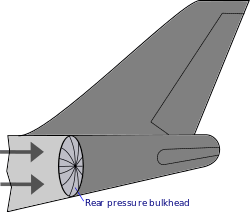Aft pressure bulkhead

The aft pressure bulkhead or rear pressure bulkhead is the rear component of the pressure seal in all aircraft that cruise in a tropopause zone in the earth's atmosphere. It helps maintain pressure when stratocruising and protects the aircraft from bursting due to the higher internal pressure.
Failure incidents
In 1971 British European Airways Flight 706 crashed in Belgium, killing all 63 on board; the cause was determined to be corrosion of the rear pressure bulkhead by fluid contamination, perhaps from the lavatory. The corrosion was not detectable by the inspection techniques at the time.
In 1985 Japan Airlines Flight 123 crashed after a catastrophic failure of the aft pressure bulkhead. The failure occurred due to faulty repair of the bulkhead after a tailstrike seven years earlier, when a single repair patch plate was incorrectly cut in two "to make it fit". Failure of the bulkhead damaged hydraulic pipes passing through. Boeing later calculated that the incorrect installation would be expected to fail after approximately 10,000 pressurizations; the repaired aircraft accomplished 12,318 successful flights before the crash.
Gallery
| Wikimedia Commons has media related to Rear pressure bulkheads (aircraft fuselages). |
-

A diagram of the aft pressure bulkhead of the Boeing 747 used on Japan Airlines Flight 123